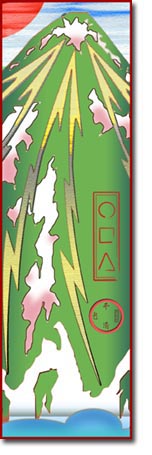On The Way: The Daily Zen Journal
The Fundamental Expedient Teachings
Tao-shin (580-651)
The fundamental teachings of mind are (1) the mind of all the Buddhas is the First Principle, based on the Lankavatara Sutra, and (2) I-hsing san-mei means that the mind which is aware of the Buddha is the Buddha, whereas the mind which does false thinking is the ordinary person, based on the Wen shu shuo po jo ching.
The Wen shu shuo po jo ching says:
Manjushri asked the World Honored One the meaning of i-hsing san-mei. The Buddha replied:
“Ultimate reality has a unified form (i-hsing). Fixing your awareness on ultimate reality is called i-hsing san-mei. If sons and daughters of noble families want to enter i-hsing san-mei, they should first listen to the Perfection of Wisdom teaching and cultivate their practice in terms of what it says.
“Later they will be able to enter i-hsing san-mei, and their awareness will be like ultimate reality: free from retrogression, indestructible, inconceivable, lacking obstructions and without form.
“Sons and daughters of noble families who want to enter into i-hsing san-mei but cannot, should stay in an enclosure empty of distractions, and give up all chaotic thoughts. Without grasping onto outward appearances, they should concentrate their minds on a particular Buddha and exclusively recite his name.
“By properly facing in the direction of the Buddha, having an upright body, and being able to continuously think on one Buddha thought after thought, means that in this contemplation they are able to see all Buddhas of the past, present, and future. Why?
“Contemplating the measurelessness and boundlessness of the merit of one Buddha is the same as the merit of countless Buddhas since they are non-dualistic and inconceivable. The Buddha’s Dharma is without distinctions. Everything conforms to the One True Suchness to achieve the most perfect realization. Therefore, everyone will attain unlimited merit and unlimited abilities by contemplating the merits of one Buddha.
“Those who would enter i-hsing san-mei in this way exhaustively know ultimate reality and the undifferentiated forms of Buddhas as numerous as the sands of the Ganges.”
Every aspect of the mind and body, even lifting a foot and putting it down, always is a place of enlightenment. All of your behavior and actions are enlightenment.
The P’u hsien kuan ching says:
“The sea of all karmic hindrances totally arises from false thinking. Those who desire to repent should sit upright and contemplate true reality.”
This is called repentence according to the First Principle, which eradicates the mind of the three poisons, the grasping mind, and the conceptualizing mind. If one continuously meditates on Buddha thought after thought, suddenly there will be clarity and serenity, and still further not even an object of thought.
The Ta p’in ching says: “No object of thought means to be thinking on Buddha.”
Why is it called wu-suo-nien? It means the mind which is “thinking on Buddha” is called thinking on no object (wu-suo-nien). Apart from mind there is no Buddha at all. Apart from Buddha there is no mind at all. Thinking on  Buddha is identical to the thinking mind. To seek the mind means to seek for the Buddha.
Buddha is identical to the thinking mind. To seek the mind means to seek for the Buddha.
Why is this? Consciousness is without form. The Buddha lacks any outer appearance. When you understand this truth, it is identical to calming the mind (an-hsin).
If you always are thinking on Buddha, grasping onto externals does not arise, and everything disappears and is without form, and thinking is impartial without false discrimination
To enter into this state, the mind which is thinking on Buddha disappears, and further it is not even necessary to indicate the mind as Buddha. When you see this, your mind is none other than the body of the real and true nature of the Tathagata.
It is also called the True Dharma; it is also called Buddha Nature; it is also called the Real Nature or Real Ultimate of various dharmas; it is also called the Pure Land; it is also called enlightenment, the Diamond Samadhi, and original enlightenment; it is also called the realm of nirvana and wisdom. Although the names are innumerable they are all the same One Essence, and do not indicate a subject of contemplation nor an object of contemplation.
When the mind is impartial like this, without fail it is made clear and pure and always appears in front of you so that the various conditions are not able to become obstructive. Why is this? Because all these phenomena are the body of the One Dharma of the Tathagata.
When one stays in this unified mind, all bondage and illusion spontaneously disappear. Within a single speck of dust are all innumerable realms. Innumerable realms are collected on the tip of a single hair. Because their original nature is suchness, there is not any mutual interference.
As briefly pointed out, it is impossible to exhaust everything when it comes to describing the methods for calming the mind. In this, skillfulness comes from the heart.
Tao-shin (580-651)
The Teachings of the Fourth Chan Patriarch
Excerpted from Early Ch’an in China and Tibet Trans by David Chappell




This translation comes from the Tun-huang documents discovered in Cave 17 sometime around 1900. While we don’t usually explore where these translations actually come from, this story deserves some attention. The Caves of the Thousand Buddhas are a collection of grottos and caves temples carved out of living rock in south eastern Tun-huang. According to an inscription the first temple was founded in 366 by a monk, and from that beginning, over a thousand large and small caves were hollowed out; 492 of them survive today covered with wall paintings and over 2,000 sculptures. In Cave 17 a treasure of tens of thousands of manuscripts and drawings were discovered from the 4th to the 10th centuries.
Tao-shin is the first Chinese master in the history of Chan whose teachings survive. The above translation was discovered by Hu shih in 1926 in 2 Tun-huang documents from Cave 17 mentioned above. The writing speaks for itself, very essential and to the point. In the first paragraph he tells us
“that the mind which is aware of the Buddha is the Buddha, whereas the mind which does false thinking is the ordinary person.”
Further down follows perhaps some of the first written instructions for meditation in the translations of Chan. And then the most subtle teachings which seem to take a lifetime to actualize:
“Every aspect of the mind and body, even lifting a foot and putting it down, always is a place of enlightenment. All of your behavior and actions are enlightenment.”
As you dive into this reading, I have included a link to view some of the caves. If you choose, you can enter them and experience the flavor of this truly awesome spiritual architecture. Feel the power of Tao-shan’s teachings in a place of peace.
With Devotion,
Elana